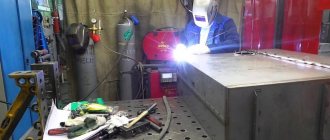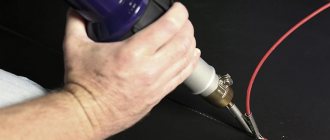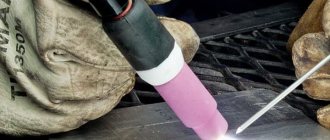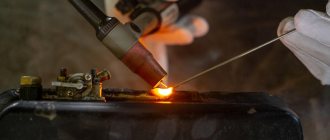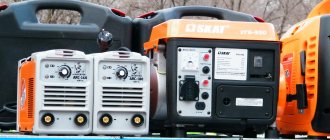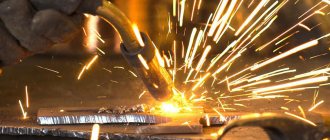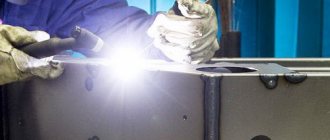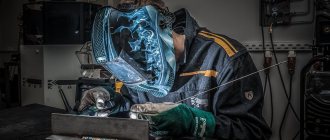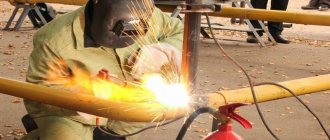When it is necessary to form a permanent connection of parts made of stainless steel, copper, titanium, aluminum, as well as a number of other non-ferrous metals and alloys based on them, argon welding is most often used. The process of its implementation is quite labor-intensive and specific.
Argon welding process
Argon welding technology
The basic principle of operation is that welding is performed using an electric arc method in a protective gas atmosphere.
Argon welding
Most non-ferrous metals, stainless steel and high-alloy steel differ from ferrous metals in that when heated they exhibit high chemical activity and interact with atmospheric oxygen, forming oxides and losing useful additives.
This significantly worsens both the properties of the weld itself and the metal in the heat-affected area. The weld becomes weak, and the alloys lose their properties due to alloying additives. The situation is even worse with aluminum and some other light metals - they ignite.
To avoid these unpleasant consequences, welding is carried out in an atmosphere of inert gas - argon, which prevents the interaction of heated metal with atmospheric oxygen. The density of argon is almost one and a half times greater than the density of air, so the inert gas replaces the air in the work area and protects it.
Argon welding can be performed with both fusible and non-fusible electrodes, usually tungsten.
Tig welding technology involves three main methods:
- MMA (RAD) manual, tungsten electrode
- MIG/MAG (AMA) automatic, infusible electrode
- TIG (AADP) – also automatic, fusible electrode
Principles of welding performed in argon environment
Argon welding combines the features of electric arc and gas welding. This technological process combines with electric arc welding the mandatory use of an electric arc, and with gas welding it combines the use of gas, as well as some technological methods for forming a permanent connection.
Melting of the edges of the parts being connected and the filler material, with the help of which the weld is formed, is ensured by the high temperature created when the electric arc burns. Gas (in this case argon) performs protective functions, which should be discussed in more detail.
Welding of alloy steels, most non-ferrous metals and alloys based on them has some features, namely that, being in a molten state, interacting with oxygen and other impurities of the surrounding air, such metals are actively oxidized.
This negatively affects the quality of the weld being formed: it turns out to be fragile, pores form in its structure - air bubbles, which significantly weaken the connection. The ambient air has an even more negative effect on aluminum melted during welding. Under the influence of oxygen in the surrounding air, this metal begins to burn.
The optimal solution, which allows you to effectively protect the area of the joint being formed when welding non-ferrous metals and alloy steels, is the use of a shielding gas - this is argon. The high efficiency of using this particular gas is explained by its characteristics.
Scheme of operation of argon arc welding
Argon is significantly heavier than air (38%), so it easily displaces air from the welding area and creates its reliable protection. Being inert in nature, argon practically does not react with molten metal, as well as other gases present in the area where the welding arc burns. When welding with argon in reverse polarity, one important point should be taken into account: in this case, electrons are easily separated from the gas atoms, the flow of which transforms the gaseous medium into a conductive plasma.
The technology for welding in a gas such as argon may involve the use of consumable as well as non-consumable electrodes (such as tungsten rods). The diameter of tungsten electrodes, which is known to be exceptionally refractory, is selected using special reference books. The choice of this parameter is influenced by the characteristics of the parts being connected.
Tig welding methods
Argon welding is divided into three types depending on the technology used:
- manual, performed with a non-consumable tungsten electrode (this technology is designated by the abbreviation RAD);
- automatic, taking place in an argon environment using non-consumable electrodes (welding designation for this type is AAM);
- automatic, performed in an argon environment using consumable electrodes (the name of this technology is AADP).
According to the international classification, a argon arc welding machine or welding performed using a tungsten electrode in a protective environment of any inert gas is designated by the abbreviation TIG (Tungsten Inert Gas).
Features of argon welding
Argon welding differs from conventional welding in several ways. The main working tool in the hardware complex is the burner. A tungsten electrode is fixed in the center, and gas flows through a nozzle.
The electric arc heats and melts the metal in the working area, the filler wire, melting, provides material for the weld. The composition of this wire must be selected so that it is as close as possible to the composition of the metals being welded.
The technological process consists of the following stages:
- Mechanical or chemical (and in case of heavy contamination - both) cleaning of welded surfaces and heat-affected zones. It is necessary to clean the surface of a lot of mechanical impurities, oil stains and oxide films.
- The ground wire from the machine is connected to the workpieces being welded. It should be noted that the filler wire is not included in the electrical circuit.
- Depending on the thickness of the parts being welded, the operating current is selected and set at the current source.
- 10-25 seconds before ignition of the arc, gas is supplied to the working area by opening the valve on the cylinder. It is important to remember that you can turn off the gas supply only 5-15 seconds after finishing the next seam.
Argon welding process
- A torch with an electrode protruding 2-5 mm should be brought to the start of the seam, as close as possible to the parts, but without touching them. The best gap at which a neat and reliable seam is obtained is approximately two millimeters.
- The filler wire should be held in front of the torch and moved smoothly along the weld line together. It is very important to insert the wire into the work area carefully and smoothly to avoid metal spatter.
- The arc is ignited without contact between the electrode and the workpiece. To do this, an oscillator is added to the circuit, generating powerful pulses with a voltage of 2 to 6 kilovolts and a frequency of up to 500 kilohertz. These pulses carry out electrical breakdown of the gas layer between the electrode and the mass.
Argon welding modes
To obtain a reliable seam, you need to choose the right argon welding modes. The key parameters are:
- Alternating or direct current.
- Welding voltage polarity.
- Operating current value.
- Argon supply rate.
Thus, alternating current is used to connect light metals, such as magnesium or aluminum. Repeated reversal of polarity destroys the film of oxides that constantly covers their surface.
Selecting a mode for argon arc welding
The role of the oscillator is not limited to the initial ignition of the arc. When working with alternating current, in order to avoid attenuation of the electric arc at the moment of polarity change, it continues to send high-frequency pulses into the welding circuit.
The operating current is determined based on several parameters:
- The metal or pair of metals being welded.
- Thickness and dimensions of parts.
- Electrode thickness.
To facilitate this choice, there are special reference tables in the professional literature and in the welding machine user manual.
The argon supply rate is set based on the following factors:
- Welding speed and filler wire feed.
- The speed of movement of air masses in the work area.
Gas consumption at direct and alternating current
If there are drafts or welding in the open air, it will be necessary to compensate for the carried argon by increasing the supply. In case of strong gusts of wind, special nozzles with mesh meshes are used to supply argon.
In addition, when working outdoors or in cases where it is not possible to completely clean the surface of the workpiece from contaminants, a small proportion of oxygen (up to 5%) is included in the working mixture to burn out impurities or turn them into slag. This principle is not applicable when working with copper, since as a result of a chain of chemical reactions the seam becomes porous and fragile.
Recommendations for choosing modes
In order for welding using argon to be performed efficiently, it is necessary to choose its modes correctly.
Important parameters when performing welding using this technology are the polarity and direction of movement of the electric current. Their choice is influenced by the properties of the materials to be welded. Alternating current or reverse polarity is chosen when it is necessary to weld parts made of aluminum, beryllium, magnesium and other non-ferrous metals. This choice is explained by the fact that when using such electric current parameters, the oxide film, which is always present on the surface of these materials, is effectively destroyed.
The nuances of working with argon welding
A typical example is the welding of aluminum, the oxide film on the surface of which has a very high melting point. When welding parts made of this metal at a current of reverse polarity, the effective destruction of the oxide film occurs due to the fact that argon ions actively bombard the surface of the parts being joined. Argon turns into conductive plasma, which not only simplifies welding work, but also significantly improves its quality. If welding of parts made of a given metal is performed using alternating current, then to achieve this effect, the parts being joined must act as a cathode.
For gas shielded welding, additional equipment such as an oscillator is often used. When welding using alternating current, it facilitates the process of igniting the welding arc, and when it lights up, it acts as a stabilizer.
At the moment when the polarity of the alternating current changes, deionization (and therefore attenuation) of the welding arc may occur. To prevent this from happening, the oscillator, when the polarity of the electric current changes, generates electrical impulses and supplies them to the welding arc.
Types of thin sheet metal joints in argon arc welding
The value of the welding current is selected depending on a number of parameters: the properties of the material being processed, the geometric dimensions of the workpieces, as well as the sizes of the electrodes used. To select this parameter, it is best to use the data contained in the specialized literature.
An important parameter is the flow rate of the protective argon gas, selected depending on the speed at which the filler material is supplied and the speed of the drifting air flows. The minimum value of this parameter will be if welding is performed indoors in which there are no drafts. If the process takes place in the open air, where strong gusts of side wind are common, it is necessary not only to increase the flow of argon, but also to use special confuser nozzles to supply it to the welding zone, the gas from which is supplied through fine-mesh meshes.
In addition to argon, oxygen is often added to the protective gas mixture in small quantities (3–5%). In this case, oxygen reacts with various harmful impurities that may be present on the surface of the parts being connected (moisture, dirt, etc.). As a result of this interaction, harmful impurities burn out or turn into slag, which floats to the surface of the weld.
One thing to keep in mind is that oxygen should not be used when welding copper because it produces copper oxide. This compound, reacting with hydrogen contained in the surrounding air, forms water vapor, which tends to escape from the weld metal. All this leads to the appearance of many pores in the formed weld, which has the most negative effect on its quality characteristics.
Advantages and disadvantages
The obvious advantages of the method include:
- High quality and durable seam
- The low degree of heating of the workpieces makes it possible to weld structures of complex shapes without deformation.
- The ability to weld materials that are chemically active when heated, which can be difficult or impossible to join in other ways.
- Increased operating speed due to high arc temperature.
In addition to the listed advantages, the method also has disadvantages:
- Complexity of the hardware complex and its settings
- High requirements for welder qualifications and skills
The disadvantages of this technology are:
- use of complex welding equipment;
- the need for special knowledge and sufficient experience in performing such work.
Argon arc welding makes it possible to make strong and durable seams, characterized by high uniformity of penetration of the welded workpieces. It allows you to weld both thin-walled and thick-walled structures made of non-ferrous metals in various combinations.
The use of argon welding allows us to obtain high-quality and reliable welded joints, characterized by uniform penetration of the parts being connected. Using argon arc welding with a consumable electrode, it is possible to weld parts made of non-ferrous metals of small thickness even without the use of filler wire.
Types of welding equipment
Several types of equipment are used for argon welding:
- Manual process - the welder holds the torch and filler material.
- Semi-automatic process - filler material and gas are supplied automatically to the torch, which the master guides along the seam manually.
- A completely mechanized process - there is no person in the work area, the supply of filler material and the operation of the burner are carried out by the operator remotely.
- Robotic process - the operator only enters the program, and the CNC system executes it.
The great advantage of the method is the ability to join materials that are difficult to weld with other methods.
This could be dissimilar metals in production, or a pipe joint in a home heating system.
Operating principle of welding equipment
The hardware complex for welding in argon includes:
- The welding machine is an inverter or semi-automatic device that develops an operating voltage of 60-70 V. It is possible to use a welding transformer or rectifier.
- An oscillator is a pulse generator with a voltage of 2-6 kilovolts and a frequency of 150 to 500 kilohertz. Serves to ignite the electric arc and maintain it when operating with alternating current.
- A device for supplying gas to the work area, including a cylinder, a reducer and a hose attached to the burner.
- Ceramic burner.
- Infusible electrode and filler material.
Tig welding process
Before welding begins, the operating parameters are adjusted and the parts are cleaned. The welder takes the torch in his right hand, and the filler wire, which is not part of the electrical circuit, in his left hand. 15-20 seconds before starting work, you need to supply gas to the beginning of the seam using a valve or argon supply button.
The electrode is brought to a distance of about two millimeters to the workpieces without touching the metal. Voltage is applied to the electrode. This is convenient to do with a foot switch. The oscillator emits a series of pulses and breaks down the gas gap, igniting the arc.
Tungsten electrodes for argon welding
The master smoothly, without jerking or touching the electrode, inserts the wire into the work area, the wire melts and fills the space between the workpieces being joined, forming the seam material. At the same time, you need to move the torch along the trajectory of the seam and supply the filler material. Manual welding requires excellent coordination of movements and a good eye.
Features of welding work in argon environment
The working body of welding equipment used to connect metal parts in a protective gas environment (including argon) is a torch. It is into the burner (in its central part) that a tungsten electrode is inserted, the projection of which should be within 2–5 mm. Fixation of the electrode inside such a torch is ensured by means of a special holder: a tungsten rod of any required diameter can be inserted into it. To supply shielding gas, the welding torch is equipped with a ceramic nozzle.
Working principle of argon welding
The required temperature during argon welding, as mentioned above, is created by an electric arc. The weld is formed using filler wire, the composition of which should best match the composition of the metal being processed.
Let us list the main stages of welding of the type in question, which uses a tungsten electrode.
- The surfaces of the parts to be joined are thoroughly cleaned from dirt, traces of oil and grease, as well as from oxide film. This cleaning is mandatory and can be done mechanically or using chemicals.
- Ground must be connected to the parts to be connected. This can be done either directly (if the parts are large) or through the metal surface of the work table (if the parts are not large). The filler wire, which is important, is not included in the electrical welding circuit, but is supplied separately.
- The welding current is set on the welding equipment. This parameter is selected depending on the characteristics of the workpieces being joined.
- After turning on the current, the torch with the electrode is brought as close as possible to the parts to be welded, without touching their surface. The optimal distance at which the torch is placed from the surface of the workpieces to be joined (this must be maintained during the welding process) is 2 mm. Holding the electrode at such a short distance allows you to thoroughly melt the metal being joined and get a beautiful and neat weld.
Diagram of welding equipment for welding in argon
- The supply of shielding gas is turned on in advance - 15–20 seconds before the start of welding. The argon supply is not turned off immediately after welding is completed, but a little later - after 5-10 seconds.
- The torch and filler wire are slowly guided only along the seam being formed, without making transverse vibrations. The filler wire, which is located in front of the torch, is introduced into the electric arc zone very smoothly, without making sudden movements. Otherwise, the molten metal will splash heavily.
- When welding, the electric arc is ignited without the electrode touching the surfaces to be joined. It is necessary to adhere to this rule for several reasons. Firstly, the ionization potential of argon is very high, which makes it difficult to effectively use a spark from touching the electrode to reduce it. When a consumable electrode is used for welding, metal vapors are generated when it touches the parts being joined. Their ionization potential is significantly lower compared to argon, which facilitates the process of igniting an electric arc. Secondly, if you touch the surface of the parts being joined with a tungsten electrode, it becomes dirty, which interferes with the quality of welding work.
TIG welding process close up
Many people naturally wonder how an electric arc can be ignited in a gas such as argon if its ionization potential is too high and the electrode itself does not touch the surface of the parts being connected. For this, an oscillator is used, which converts the current coming from the electrical network with conventional parameters into high-frequency pulses with a voltage value of 2000–6000 V and a current frequency of 150–500 Hz. It is these impulses that make it possible to ignite an electric arc without the electrode coming into contact with the parts being connected.
Argon grades used in welding
State Standard 10157-79 defines three grades of argon for use in welding:
- A - contains 99.99% argon, used for working with chemically active and rare metals, such as titanium or zirconium, and for final welding of particularly important structures.
- B - contains 99.96% argon, used for working with aluminum and magnesium alloys and other materials exposed to gases soluble in the metal.
- B - contains 99.90% argon, used for working on stainless steel, alloyed high-strength and heat-resistant steels, as well as pure aluminum.
Technical characteristics of argon for welding
All argon produced by industry is certified according to one of three grades.
Do-it-yourself welding work
It is quite possible for a home craftsman who has sufficient knowledge and skills in the field of electrical engineering, welding and plumbing to independently assemble a hardware complex for manual argon arc welding.
To do this you will need:
- Transformer with ammeter to monitor operating current.
- A switch, or contactor, that supplies voltage to the electrode.
- An oscillator with an inductive-capacitive filter and a relay for turning it on.
- Argon supply regulator.
- Argon burner.
- Cylinder, reducer and gas hose.
- Tungsten electrodes of various diameters.
- Power supply for switching devices with 24 V voltage.
- Electrically operated gas valve.
- Oscillator switching relay.
- Ballast to reduce the direct current component, connected to a break in the welding circuit. Instead of a special device, an old 50-80 ampere-hour car battery will do.
- Welder personal protective equipment: mask, leggings, canvas workwear with non-flammable impregnation.
All these elements of the complex can be purchased relatively inexpensively. However, if you don’t have confidence in your abilities as an electrical engineer and gas engineer, or time is expensive, such a TIG hardware complex is offered on the market at a price of 20 thousand rubles.
Equipment and equipment for argon welding
To perform argon welding, it is not enough to have a standard welding machine, which can be an inverter or transformer. This technology requires the use of such equipment and special equipment as:
Inverter welder and gas cylinder for welding using argon
- an inverter or a regular welding transformer, the power of which should be sufficient to carry out such a technological process (in particular, for these purposes you can use a transformer whose no-load power is in the range of 60–70 V);
- a power contactor through which the required welding voltage will be supplied to the welding torch;
- an oscillator, the purpose of which was mentioned above;
- a special regulator that will be responsible for the time of blowing the welding zone with argon (since the shielding gas must begin to flow a few seconds before the start of welding, and its supply must be turned off a few seconds after its completion);
- a special torch with a ceramic nozzle and a clamp for fixing the tungsten electrode;
- gas cylinder and reducer, which regulates the level of argon pressure supplied to the welding zone;
- tungsten electrodes and filler rods of the required diameter;
Repairing an alloy wheel - a typical use of argon welding
- an additional transformer responsible for supplying voltage to switching devices;
- a rectifier that generates a direct electric current with a voltage of 24 V, which is supplied to switching devices;
- a relay that is responsible for turning on and off devices such as the oscillator and contactor;
- electrogas valve operating on 24 or 220 V;
- an inductive-capacitive filter that protects the welding machine from the negative effects of high-voltage pulses;
- ammeter used to measure the welding current;
- a working or faulty car battery with a capacity of 55–75 Ah, which is necessary in order to reduce the direct component of the welding current that necessarily arises when performing the process on alternating current (such a battery is connected to the welding electrical circuit in series);
- welding glasses, which must be used as the main element of protection for the welder.
If desired, you can equip the equipment for argon welding with your own hands by purchasing all the necessary components at a hardware store or on the market. If you do not want to engage in design, then you can immediately purchase a welding machine whose brand contains the abbreviation TIG. To start using such a device, it must be additionally equipped with a gas cylinder, a burner, elements that control the burner and the supply of protective gas.


